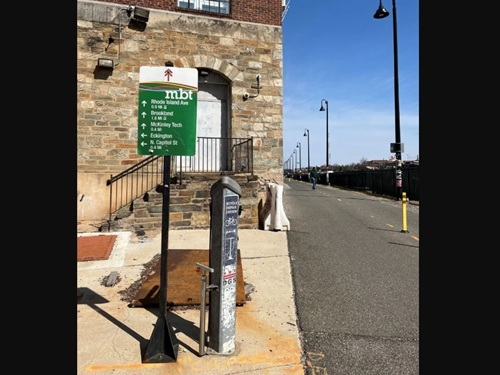The Colorado Department of Transportation has published a draft of an updated Statewide Active Transportation Plan that seeks to beef up safety and convenience for pedestrians, bicyclists, and others engaged in non-motorized mobility.
[Above photo by Colorado DOT]
That plan – made available for public review and comment though July 18 – is viewed as an ambitious update to the agency’s 2012 Statewide Bicycle and Pedestrian Plan. While the 2012 plan “provided a big picture view of walking and biking needs,” the active transportation world has evolved, said Mayra Washburn, policy and programs communications manager for Colorado DOT.
“Much has changed since the 2012 plan was developed, including many new data sources on active modes, the emergence of new micro-mobility devices like e-scooters, and the rise in traffic fatalities for vulnerable roadway users,” Washburn said. “The new plan provides insights on these changes and identifies how Colorado DOT can work to improve bicycling and walking opportunities for Coloradans across the state.”
Once it is finalized, the plan will give Colorado DOT and its partners a set of policies, strategies, and tools to uniformly evaluate, prioritize, and develop active transportation projects that compete for limited funding.
To prepare for the 2025 update, Colorado DOT consulted with representatives from local governments, regional planning organizations, other agencies, and active transportation advocacy groups. The agency also conducted a three-month statewide public survey, which garnered 3,099 responses.
Many survey respondents said it’s often just too far to walk or bike, even to get to or from a transit point. The plan acknowledges this “first/last mile gap…and if there is no way to safely walk, bike, and/or roll for those first and last miles, people will be less likely to choose transit over a personal vehicle for longer trips, even if the actual transit service is convenient.”
One action step is to identify those gaps “especially in places where we know people want and need these options,” the plan states. Colorado DOT plans to complete that list by July 1, 2026, to “help us focus on projects that will make the biggest difference in improving safety and making it easier for people to walk, bike, roll, and take transit.”
Other barriers to active transportation include heavy traffic, not enough sidewalks or bike lanes and “concerns for personal safety.”
Recently, Colorado has averaged “approximately 100 fatalities and 500 serious injuries” a year for vulnerable road users, defined as pedestrians and bicyclists, the plan states. Compared to 2013, annual pedestrian and bicyclist fatalities “have surged by 161 percent and 67 percent, respectively, as of 2023.”
Safety emerged as one of the top concerns in the plan, which spelled out 19 safety strategies to improve active transportation. One strategy states Colorado DOT will “prioritize safety impacts over operational impacts when evaluating projects.”
“This strategy clarifies that safety for all roadway users is paramount for project development and evaluation,” Colorado DOT’s Washburn said. “As noted in the plan, this strategy is already in progress.”
Other safety strategies include setting “safe and realistic speed limits” by including multiple road and traffic factors, including active transportation activity; addressing design deficiencies such as inadequate lighting, insufficient sight distance, and substandard turning radii at high-risk intersections; and designing roads to promote lower vehicle speeds in areas conducive to active transportation.
The 100-page plan recognized Colorado DOT’s many active transportation accomplishments since the 2012 plan was published, including:
- Publishing the Pedestrian Crossing Installation Guidelines and Guidelines for Pedestrian Signal Timing.
- Improving the Safe Routes to School program.
- Updating the Statewide Bicycling Manual.
- Planning, designing, and implementing Interstate Mobility Hubs.
Colorado DOT said it plans to review public comments about its proposed update to the state’s active transportation plan through July and August for possible changes, with the goal of having the plan finalized and approved in September.
Other state departments of transportation are engaged in similar active transportation plan updates.
In May, the Michigan Department of Transportation sought public input on a draft of its North Region Active Transportation Plan, which highlights current and proposed nonmotorized connections throughout the northernmost 21 counties of Michigan’s Lower Peninsula.
The agency said it worked with the Northeast Michigan Council of Governments (NEMCOG), private firm Networks Northwest, and local communities throughout those 21 counties to develop this plan, which will formally “assemble” both current and future separated pathways, bike lanes, wide shoulders, sidewalk connections, and regional trails into a single system.
In September 2024, the Maryland Department of Transportation began developing what it calls a “landmark action plan” to improve and expand trail connectivity statewide.
The agency said this plan will guide future investment in shared-use paths, helping to advance efforts to reduce greenhouse gas emissions, boost alternatives to driving, and prioritize the safety of all road users across the transportation network.
In May 2024, the Utah Department of Transportation issued nearly $95 million to support 19 trail projects – including the construction of new paved trails as well as funding for planning efforts to fill in existing trail gaps – as part of creating a regional “Utah Trail Network” across the state.
The agency said that it collaborated with communities statewide regarding the allocation of that funding – approved by the Utah Transportation Commission – to select the key projects for this statewide trail network.
Additionally, the Texas Department of Transportation is developing a Statewide Active Transportation Plan or SATP to gather recommendations for improving bicycling, walking, and rolling conditions across the Lone Star state.
TxDOT noted the SATP is being integrated with its other long-range mobility plans to help it maintain a safe, accessible, connected, and fully integrated multimodal transportation system for the future, since the population of Texas is expected to grow by 28 percent by 2050.
 Active Transportation
Active Transportation



